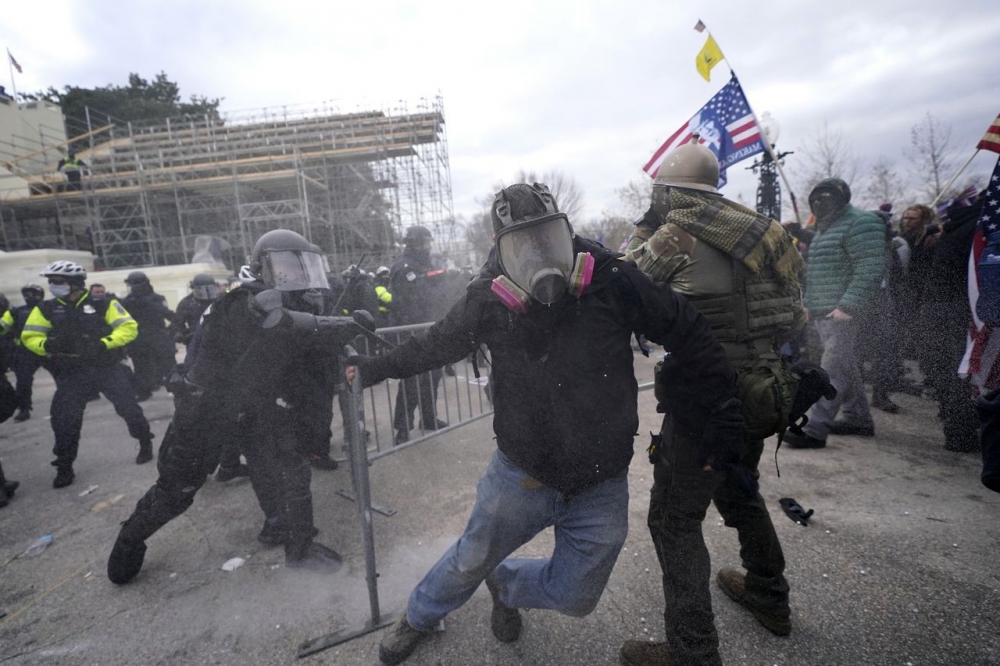
A Threat Reconsidered

In an age of hyperpartisan divide, we’ve become accustomed to the idea that a large portion of Americans support political violence. After all, considerable polling data seem to validate the notion.
But a new paper in the Proceeding of the National Academy of Sciences co-authored by a UC Santa Barbara scholar finds such support is vastly overstated — and argues flawed survey questions and over-representation of politically disengaged respondents badly skew polls on the acceptability of political violence.
“The core insight of our paper is that biased measurement on surveys can lead policy makers to adopt decisions based on misleading statistics,” said Clayton Nall, an associate professor of political science. “We show that support for partisan violence is not tied to our growing partisan affective polarization (that is, people adopting their partisanship as a social identity and developing strong negative affect towards the other side). We do not find evidence that partisan animosity is driving support for political violence as a mass phenomenon. While any amount of support for political violence is worth concern, the notion that about a third of the country casually supports violence is not supported by carefully worded and specific survey questions.’
To gauge genuine support for political violence, the researchers used four survey experiments that assessed the respondents’ reactions to specific acts of violence. That’s how they identified that ambiguous survey questions result in overestimates of support for violence. As the paper notes, “Prior studies ask about general support for violence without offering context, leaving the respondent to infer what ‘violence’ means.”
But specifying a particular violence, the researchers found, significantly reduced support for it. Assault and murder, for instance, attracted minimal support while petty property crimes gained more support, albeit still low. What’s more, nearly all respondents said those who commit serious violence should be charged criminally.
The survey experiments also found that respondents who were politically disengaged skewed survey results toward greater acceptance of violence. That’s because previous surveys didn’t give respondents an “I don’t know” option. As the paper notes, this prompts the politically disengaged to select an arbitrary response.
Random responses are trouble, the paper reports, because current violence support scales “are coded such that four of five choices indicate acceptance of violence. In the presence of arbitrary responding, such a scale will overstate support for violence. Across all four studies, we show that disengaged respondents report higher support for violence.”
Nall, who contributed to the study’s design of the first wave of research vignettes, said disengaged respondents are an ongoing problem in survey research.
“They constantly threaten to compromise survey research, especially in the sorts of online surveys that are often conducted by university researchers,” he said. “Just because you can ask a complicated or controversial question does not mean you’ll get an accurate or well-considered answer.
“This is a reality that survey researchers have known for a long time,” Nall continued, “but this lesson can be forgotten when results point in the direction of our favored hypothesis. Our study asked both less vague questions and constructed the offered choices so as to isolate and discourage inattentive or disengaged respondents from contributing to misleading statistics.”
At a time when political violence can seem almost inevitable, the paper offers a rare bit of good news. That doesn’t mean, however, that we won’t see any political violence, Nall said.
“But there is a big difference between a study that shows that a third or more of the public endorses political violence, and one that instead finds that such support hovers in the low single digits,” he said. “Moreover, it should be a very promising sign that so few Americans — even when they may have strong partisan feelings — embrace or endorse use of force against members of the other party.”
Even if the likelihood of political violence is low, Nall said the perception that it’s a strong threat can come back to bite us in other ways. He likes to paraphrase a famous line from Yale political theorist Robert Dahl: For most Americans, “politics is a sideshow in the great circus of life.” They might endorse “correct” partisan positions, he noted, but they’re not embracing or motivated to support policy. And while they might be led to answering affirmatively in a vaguely worded survey about violence, they are rather unlikely to support specific acts of violence in service of political causes.
“The numbers we obtain — probably closer to 7% of the population really supporting political violence in a meaningful way — are consistent with Dahl’s insight,” he said.
But here’s where the danger lies: One might look at the report’s conclusion and say that even one person, or even a tiny minority supporting violence is too many. But that comes with its own set of dangers.
“The problem with doing so is that the cure may become worse than the alleged disease,” Nall said. “The numbers matter, and policy responses need to be proportional to the problem, particularly when civil liberties are at stake. Survey-based studies suggesting that 30% or even 40% of the population embrace political violence — when our work suggests a realistic number is closer to 7% — may lead politicians to adopt a disproportionate response, or adopt policies that undermine civil liberties.”



